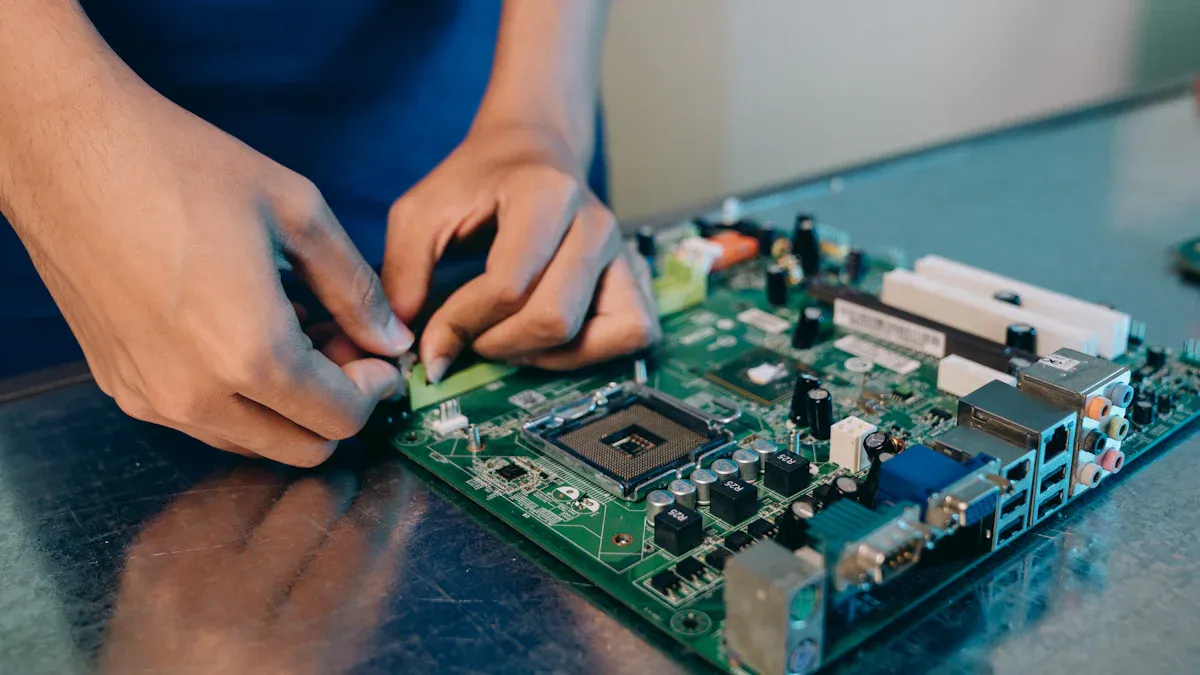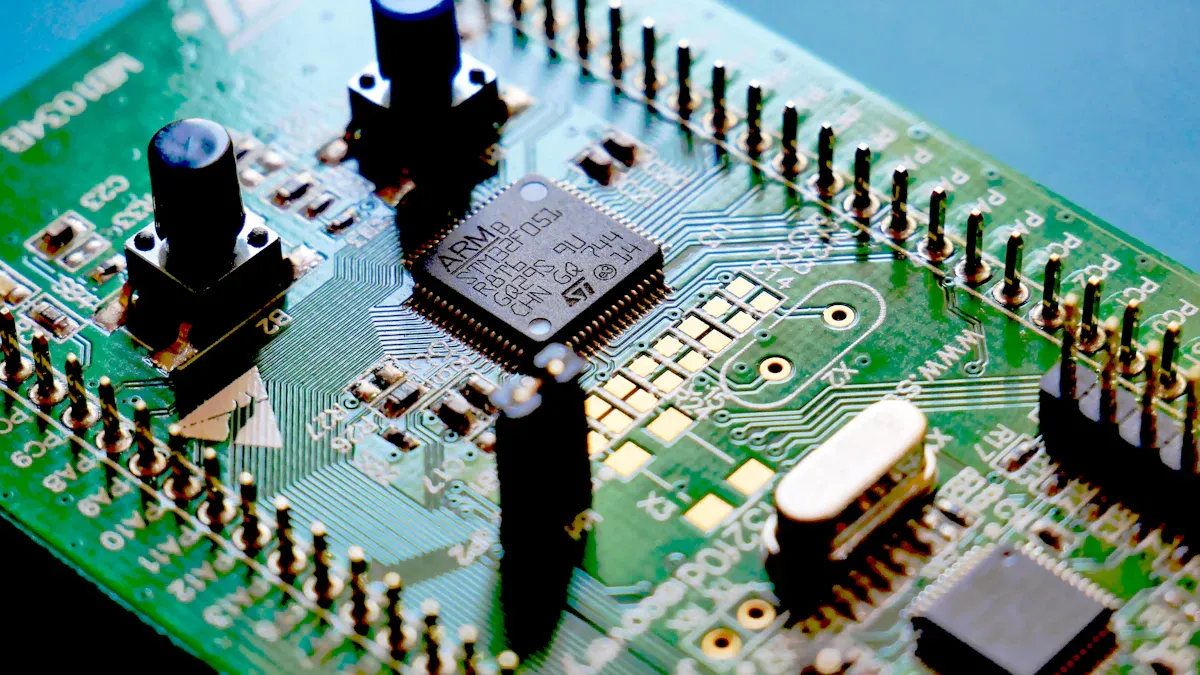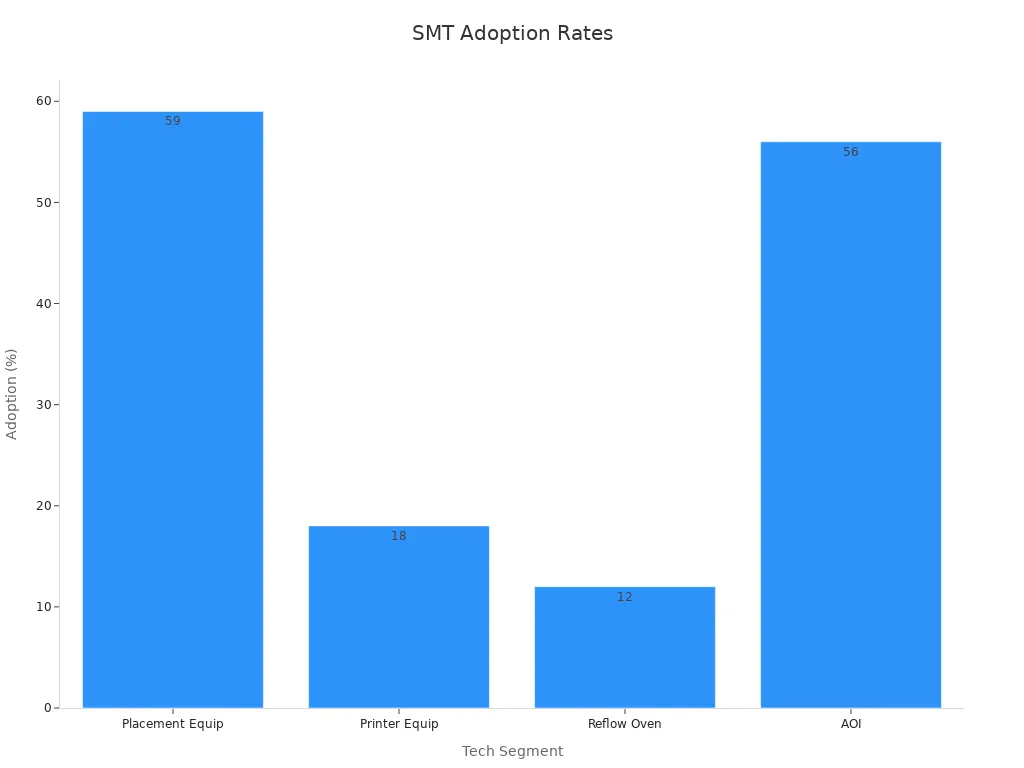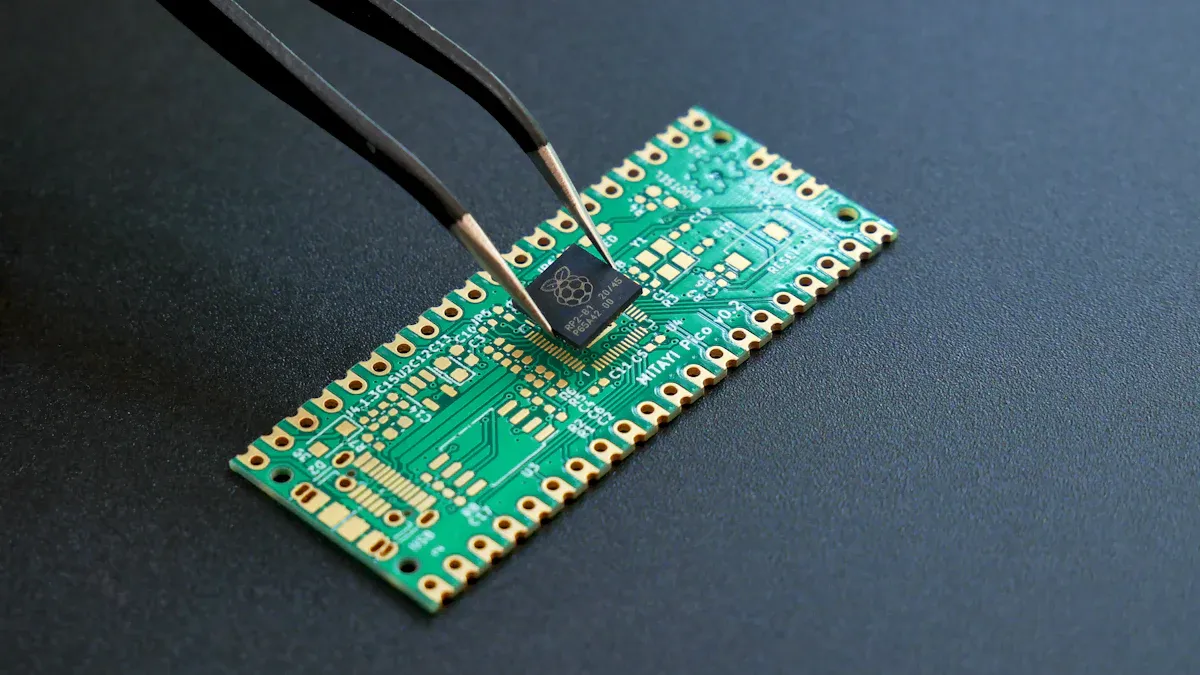How Modern PCB Technology Ensures Top-Quality Manufacturing

Modern pcb technology uses new machines and careful steps to make strong pcb and good circuit boards. Quality checks in pcb making make sure each printed circuit board and pcba is safe. LT CIRCUIT is a leader with new ways to put parts together, test, and check quality. Machines, tests, and test ways help make the best pcbas.
Key Takeaways
Modern PCB technology uses new machines and smart tests. These help make strong and reliable circuit boards. There are fewer mistakes and boards are made faster.
Automation and AI help put parts in the right place. They find problems fast and keep the quality high. This also lowers costs and makes assembly quicker.
Careful checks and tests look for problems early. These include optical, X-ray, and functional tests. They make sure every PCB is safe and meets high standards.
Modern PCB Technology & Equipment

LT CIRCUIT’s Advanced PCB Solutions
LT CIRCUIT leads in modern pcb technology. They make high-quality printed circuit boards and pcba for many industries. The company uses special materials like high-frequency laminates and metal core substrates. These help the boards handle heat better and keep signals strong. HDI technology lets engineers design smaller and more complex pcb. It uses microvias, buried and blind vias, and laser drilling. These new ideas help make multilayer pcb with over 20 layers. They can line up layers with ±25μm accuracy.
LT CIRCUIT uses precision lithography systems in pcb fabrication. These systems can reach 1μm resolution. They also use advanced plating to make 15μm line/space shapes. The company cares about quality. They use surface finishes like ENIG. ENIG helps the boards work well for 5G. LT CIRCUIT uses AI and machine learning. These tools help with design, fixing problems, and making sure production is good. This makes pcba manufacturing more reliable.
LT CIRCUIT’s Online Automated Optical Inspection system finds 99.5% of defects. It works five times faster than people. This system lowers rework costs by 40%. It also makes production 20% faster for automotive pcb. The system meets strict IPC Class 3 and ISO/TS 16949 rules.
SMT & Automation
Surface Mount Technology (SMT) and automation have changed pcba assembly. Modern pcb technology uses fast pick-and-place machines, stencil printers, and reflow ovens. These machines make assembly easier. Pick-and-place machines can put down over 50,000 parts each hour. They are 99.95% accurate. Stencil printers can place solder with ±5μm accuracy. Reflow ovens keep heat steady within ±0.5°C. This makes strong solder joints and good printed circuit board assembly.
Technology Segment | Adoption/Market Share (2023) | Performance Metrics / Key Data Points | Drivers and Trends |
|---|---|---|---|
Placement Equipment | Placement speeds >50,000 components/hour; modular heads; advanced vision systems | Growth in automotive, consumer electronics, Industry 4.0 integration | |
Printer Equipment | 18% of SMT shipments | ±5 µm deposition accuracy; 300–400 boards/hour; <20 µm solder paste deposits | Demand for fine-pitch components; dual-paste capability; 1.2 million prints in 2023 |
Reflow Oven Equipment | 12% of SMT shipments | Thermal control ±0.5 °C; 6–12 zones; ~20,000 boards/day throughput | Supports leaded/lead-free soldering; 95% process repeatability |
56% adoption among U.S. manufacturers | AI-based defect classification; real-time SPC | Industry 4.0 integration; quality-driven SMT upgrades | |
Shipment Volumes | 6,212 SMT lines shipped in 2023 | Projected growth to 9,406 units by 2031 | Supply chain bottlenecks and skill shortages restrain growth |
Application Highlights | Consumer Electronics: ~33% of SMT lines; Telecommunications: ~20% | Ultra-fine placement heads; 3D AOI on 68% of new lines | IoT proliferation, automotive electronics surge, 5G network hardware growth |

Automation in pcba manufacturing saves time and increases output. AI and machine learning help place parts and learn new pcb designs. Modular machines let companies make more boards when needed. Industry 4.0 and smart factories help with fixing machines, checking from far away, and watching in real time. This lets factories work all day and night and react fast to changes.
Fast pick-and-place machines put parts on boards quickly and accurately.
Automated reflow soldering makes strong solder joints and fewer mistakes.
Automated optical and X-ray inspection find problems with parts and soldering.
Automation lowers labor costs, makes more boards, and keeps quality high.
Inspection Systems
Inspection systems help keep quality high during pcb and pcba making. Automated optical inspection uses cameras and AI to find tiny problems. These include bad soldering and parts that are not lined up. X-ray inspection finds hidden problems inside the board. This is important for multilayer pcb and advanced printed circuit boards.
Modern inspection tools find problems early. This saves money and improves how many good boards are made. In-circuit and flying probe tests check if the board works right. They find open or short circuits and wrong parts. Functional testing checks if the board works in real life. This lowers the chance of problems later and makes boards more reliable.
Automated optical inspection finds surface problems and missing parts early.
X-ray inspection finds hidden problems and helps multilayer pcb last longer.
In-circuit and functional testing check if the board works and is strong.
Environmental stress testing checks if the board can handle tough conditions.
AI inspection systems find problems fast and help keep quality high.
LT CIRCUIT’s inspection systems make sure boards are always good. Their online AOI system cuts defect rates from 7% to 1.2%. This saves clients a lot of money. Early users see up to 40% more good boards and 25% faster production. These results show why good test equipment and methods matter in modern pcb technology.
Note: Using automated inspection, advanced test tools, and real-time data makes sure every pcba is top quality and reliable.
PCB Testing & Quality Control

Good pcb testing and quality checks are very important. They help make sure pcba is safe and works well. Each step uses special machines and careful tests to stop mistakes. This helps the boards last a long time. LT CIRCUIT works hard to keep quality high. They use Six Sigma and check data to control how things are made. This makes them a top company in the field.
AOI & X-ray Inspection
Automated optical inspection is a key tool for testing pcb. It uses cameras to look at each pcba and compare it to a good design. The system finds missing parts, things not lined up, and bad solder joints. It also finds problems with the lines on the board. AOI sorts problems, saves data, and helps fix things fast. This helps lower mistakes and makes boards better.
X-ray inspection works with AOI to find hidden problems. It can see inside the board and find bubbles or bad solder under parts like BGAs. AOI cannot see these problems. X-ray gives numbers about inside connections. This helps check quality very well. Companies use this data to watch for problems, change how they work, and make boards better.
AOI and X-ray together check a lot, find problems fast, and help make pcba better all the time.
In-Circuit & Flying Probe Testing
In-circuit testing and flying probe testing are important for checking if boards work right. In-circuit testing uses a bed-of-nails to test for shorts, opens, and if parts are right. This is good for making lots of the same board. It is fast and does not cost much for each board. It checks if every board is made right.
Flying probe testing uses moving probes, not a fixed bed. It is good for new boards, small batches, and tricky designs. It can reach small spots and find shorts, opens, and other problems. Flying probe testing is quick to set up for new designs. Both tests help find mistakes and check if parts are correct.
In-circuit testing is fast and good for big jobs.
Flying probe testing is flexible and good for new or hard boards.
Both tests help stop mistakes and keep boards working well.
Functional & Burn-In Testing
Functional testing checks if each pcba works like it should in real life. It tests every part and function. Machines do these tests to make sure results are the same each time. They check things like heat, power, and how fast signals move. The data helps companies make better boards and get more good ones.
Burn-in testing puts boards through heat, power, and stress for a long time. This finds weak parts and early failures. Burn-in testing lowers the number of boards that break soon after being made. It also helps guess how long a board will last. Numbers like DPPM, FIT, and MTTF show how strong and long-lasting the boards are.
Metric / Aspect | Description | Relevance to Reliability and Longevity |
|---|---|---|
DPPM | Counts early failures in big groups of boards. | Lower DPPM means boards are more reliable. |
FIT | Tells how many fails in a billion hours. | Helps guess how often boards will fail over time. |
MTTF | Shows how long before the first failure happens. | Higher MTTF means boards last longer. |
Test Duration | Boards are tested for 48 to 168 hours straight. | Finds weak spots and early problems. |
Performance Monitoring | Watches power and signals all the time. | Finds small problems and slow damage. |
Testing the circuits and doing a final check makes sure only the best pcba go to customers.
Compliance & Traceability
Following rules and tracking everything helps keep quality high in pcb making. Product Lifecycle Management systems keep all the data in one place. They track changes and help with paperwork for rules. These systems keep records, control versions, and help meet rules for things like cars, planes, and hospitals.
Compliance Metric / Traceability Data | Description | Relevance to International Standards |
|---|---|---|
Counts mistakes during making boards | Lower rates mean better quality (ISO 9001) | |
Yield | Shows how many boards pass tests | High yield matches ISO 9001 rules |
Automated Optical Inspection | Finds parts not lined up or bad solder | Helps meet ISO 9001 rules |
In-Circuit Testing | Checks if parts are connected right | Needed for ISO 9001 |
Component Authenticity Verification | Makes sure parts are real | Needed for ISO 9001 and UL 796 |
Traceability Systems | Tracks batch numbers and papers | Needed for RoHS and FDA rules |
Tracking helps find where problems start and helps with checks. It also makes sure rules are followed. Using smart tech like RFID and barcodes helps get data fast and make work better.
LT CIRCUIT uses Six Sigma and checks data to watch important things, cut mistakes by half, and make the process better. These steps make sure every pcba is safe, strong, and high quality.
Modern PCB technology uses new machines and careful tests. These help LT CIRCUIT make strong circuit boards and reliable pcba. Automated test systems and functional testing check for problems. Compliance test methods help stop mistakes. These steps make quality better and lower errors. As pcb designs get harder, new test tools and AI will help even more. They will keep making pcba better and more reliable.
Automated test systems and functional testing find about 70% of pcb problems. Compliance test methods help lower failures by 30%.
New materials and AI inspection will make pcb testing and pcba work even better. Industry trends show these changes will help a lot.
FAQ
What makes LT CIRCUIT’s PCB manufacturing different?
LT CIRCUIT uses new machines and smart testing. They also use automation to help make boards. These steps help make sure the PCBs are strong and work well for many jobs.
How does automation improve PCB quality?
Automation puts parts in the right place every time. It helps stop people from making mistakes. It also makes the work go faster.
Fewer errors
Quicker building
Same good results each time
Why is AOI important in PCB production?
Benefit | Description |
|---|---|
Fast Detection | Finds problems very quickly |
High Accuracy | Catches even small mistakes |
Data Tracking | Saves test results |
See Also
Step-By-Step Guide To The PCB Production Process
Essential Tips For Excelling At PCB Quality Control
Selecting A Reliable PCB Manufacturer For Your Company
Industrial Rigid PCB Production: Materials, Methods, And Standards
Top Materials Recommended For High-Speed PCB Design Projects
